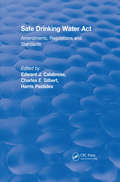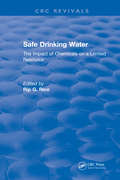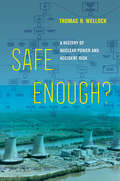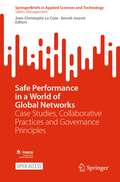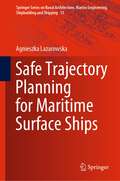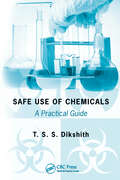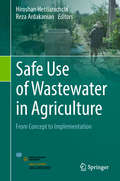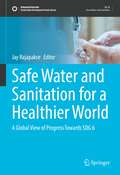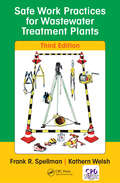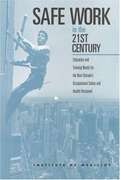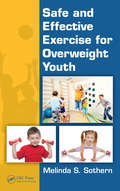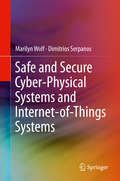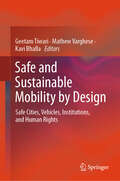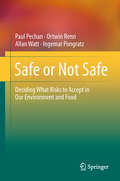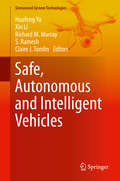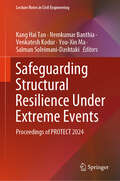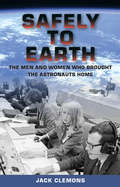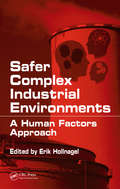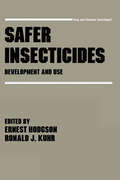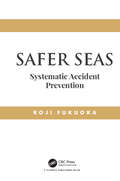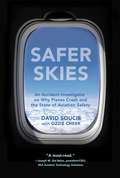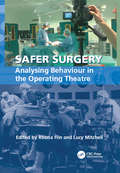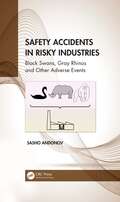- Table View
- List View
Safe Drinking Water Act (CRC Press Revivals)
by Edward J. CalabreseThis new book covers drinking water regulations such as disinfectant by-products, synthetic organics, inorganic chemicals, microbiological contaminants, volatile organic chemicals, radionuclides, fluoride, toxicological approaches to setting new national drinking water regulations, and trihalomethanes. In addition, organic and inorganic compounds scheduled to be regulated in 1989 and new candidates for the 1990s regulations are detailed.
Safe Drinking Water for the Immunocompromised
by Anthony M. WachinskiImmunocompromised persons are more vulnerable than the general population to contaminants in drinking water and include persons with cancer undergoing chemotherapy, cancer survivors, transplant recipients, individuals with HIV/AIDS or other immune disorders, some elderly, infants, and pregnant mothers. Safe Drinking Water for the Immunocompromised provides information about safe drinking water choices for the immunocompromised community, pregnant mothers, and the medical professionals from whom they seek advice. The book serves as a primer on drinking water regulations, water chemistry, as well as the terminology used to describe water contaminants, and includes a glossary that explains the terms and concepts in a straightforward manner.• Offers a science-based rationale for the acceptable level of a contaminant and sources of drinking water that meet or exceed these levels.• Presents and explains numerous contaminants of concern found in water.• Explains the different types of purification for bottled water, including reverse osmosis, distillation, and deionization.
Safe Drinking Water: The Impact of Chemicals on a Limited Resource (CRC Press Revivals)
by Rip G. RiceA review of the nation’s new coverages serves as a ready reminder that drinking water safety is more than regional of local concern. In recent times, the print media alone has drawn attention to barium, bacteria, heavy metals, and increasingly organic contaminants, in public water supplies located in Florida, Rhode Island, Texas, Oregon, Illinois, Minnesota, North Carolina, Michigan, and California, to name a few. In an effort to address one of the major issues confronting the future of the nation’s drinking water supplies, chemical contamination, the Drinking Water Research Foundation and the American Chemical Society presented the symposium, "Safe Drinking Water: the Impact of Chemicals on a Limited Resource." To add balance to the total presentation, two papers were included that were not part of the symposium. Many questions as to the public significance of hundreds of organic chemicals known to be present in the national drinking water supply are waiting to be answered. In some areas of the country, aid rain-induced alterations of the natural leaching process represent an unexplored potential source of toxic pollutants. Finding workable ways to clean up the water supply will be an ongoing task. Addressing these questions, as well as investigating how other countries are responding to these problems, the alternate sources available, such as bottled water, and point of use devices, the presenters in this symposium have attempted to explain the problems, situation, and alternatives. As progress is made in one area, setbacks will occur in another. As we eliminate problems thought chemical technology, we often create others, such as contamination of our waters. While all the situations, problems, and alternatives are not discussed in these proceedings, it is hoped that some attention will be brought to the public, government, and private sectors so that future work will be done to assure the nation of safe drinking water resources.
Safe Enough?: A History of Nuclear Power and Accident Risk
by Thomas R. WellockSince the dawn of the Atomic Age, nuclear experts have labored to imagine the unimaginable and prevent it. They confronted a deceptively simple question: When is a reactor "safe enough" to adequately protect the public from catastrophe? Some experts sought a deceptively simple answer: an estimate that the odds of a major accident were, literally, a million to one. Far from simple, this search to quantify accident risk proved to be a tremendously complex and controversial endeavor, one that altered the very notion of safety in nuclear power and beyond. Safe Enough? is the first history to trace these contentious efforts, following the Atomic Energy Commission and the Nuclear Regulatory Commission as their experts experimented with tools to quantify accident risk for use in regulation and to persuade the public of nuclear power’s safety. The intense conflict over the value of risk assessment offers a window on the history of the nuclear safety debate and the beliefs of its advocates and opponents. Across seven decades and the accidents at Three Mile Island, Chernobyl, and Fukushima, the quantification of risk has transformed both society’s understanding of the hazards posed by complex technologies and what it takes to make them safe enough.
Safe Medical Devices For Children
by Institute of Medicine of the National AcademiesInnovative medical devices have helped reduce the burden of illness and injury and improve the quality of life for countless children. Mechanical ventilators and other respiratory support devices rescue thousands of fragile newborns every year. Children who once would have died of congenital heart conditions survive with the aid of implanted pacemakers, mechanical heart valves, and devices that close holes in the heart. Responding to a Congressional request, the Institute of Medicine assesses the system for postmarket surveillance of medical devices used with children. The book specifically examines: The Food and Drug Administration’s monitoring and use of adverse event reports The agency's monitoring of manufacturers’ fulfillment of commitments for postmarket studies ordered at the time of a device’s approval for marketing The adequacy of postmarket studies of implanted devices to evaluate the effects of children’s active lifestyles and their growth and development on device performance Postmarket surveillance of medical devices used with children is a little investigated topic, in part because the market for most medical products is concentrated among older adults. Yet children differ from adults, and their special characteristics have implications for evaluation and monitoring of the short- and long-term safety and effectiveness of medical devices used with young patients.
Safe Performance in a World of Global Networks: Case Studies, Collaborative Practices and Governance Principles (SpringerBriefs in Applied Sciences and Technology)
by Benoît Journé Jean-Christophe Le CozeThis open access book provides an analytical and critical outlook, by leading scholars, of the impact of various trends in the quality of collaboration and resulting safety outcomes that arise from the evolution of traditional integrated production within a single firm into a complex web of partnerships and supply chains. In the face of increasing fragmentation within industrial production and the associated rise in the complexity of inter-organizational communication and transaction, this book analyses causal factors such as cost pressures, globalization of demand, increasingly flexible resource allocation and work organization, changes in legal liability and the possibilities afforded by information technology. Various case studies focus on the effects of crossing boundaries between organizations, between different trades and professions and between countries, assessing the effect of variations in regulatory structures and national cultures. Furthermore, they illustrate the wide range of organizational forms to be found in high-hazard industries today and the impact, potential or real, of the variety of forms of partnership on safety and well-being at work. The contributors assess the effect of out-sourcing and of various forms of partnership and governance on safety at work and how they can be made to support the prevention of major accident hazards.
Safe Trajectory Planning for Maritime Surface Ships (Springer Series on Naval Architecture, Marine Engineering, Shipbuilding and Shipping #13)
by Agnieszka LazarowskaThis book offers a comprehensive review of collision avoidance techniques and safe trajectory planning for manned and unmanned ships, together with extensive information on how to develop and implement algorithms for applications in real-world settings. It describes the most relevant decision-support systems and guidance systems used in the control of marine craft, giving a special emphasis to autonomous vehicles, but also covering manned ones. Thanks to its good balance of theory and practice, and the inclusion of basic explanations of all essential concepts, this book fills an important gap in the literature of marine navigation, providing not only researchers and practitioners with a timely reference guide to safe trajectory planning, but also supporting students and newcomers to the field.
Safe Use of Chemicals: A Practical Guide
by T.S.S. DikshithOccupational workers frequently use, store, and dispose of toxic chemicals without knowing the possible consequences, both for the workplace and the environment. Improper use or misuse of chemical substances can result in health disorders, fatalities, or chemical disasters. Exceptionally comprehensive, this guide provides an important service by collecting substantiated information on a huge number of chemicals. It covers their safe handling in a variety of settings, including work, domestic, and scientific settings. The text reviews aspects of toxicology including toxic symptoms, sources, safe handling, possible health hazards, long-term consequences of improper use, and management. The book covers drugs, pollutants, pesticides, industrial solvents, medical compounds, and food additives. It also reviews chemical classifications and regulatory systems.
Safe Use of Wastewater in Agriculture: From Concept To Implementation
by Reza Ardakanian Hiroshan HettiarachchiThis book offers a broad and global level description of the current status of wastewater use in agriculture and then brings the readers to various places in the MENA Region and Europe to explain how some countries and regions have addressed the challenges during implementation. On a global scale, over 20 million hectares of agricultural land are irrigated using wastewater. This is one good, and perhaps the most prominent, example of the safe use potential of wastewater. Water scarcity and the cost of energy and fertilisers are among the main factors driving millions of farmers and other entrepreneurs to make use of wastewater. In order to address the technical, institutional, and policy challenges of safe water reuse, developing countries and countries in transition need clear institutional arrangements and more skilled human resources, with a sound understanding of the opportunities and potential risks of wastewater use. Stakeholders in wastewater irrigation who need to implement from scratch or improve current conditions, find it difficult to gather the necessary information on practical implementation aspects. The main objective of this book is to bridge that gap.
Safe Water and Sanitation for a Healthier World: A Global View of Progress Towards SDG 6 (Sustainable Development Goals Series)
by Jay RajapakseThis volume presents a review of global progress made towards achieving Sustainable Development Goal 6 (SDG 6): Clean Water and Sanitation, part of the United Nations 2030 Agenda for Sustainable Development. It builds on the latest data and statistics provided by the UN and other international organizations through chapters written by a wide variety of authors, including representatives of government ministries and departments, members of international organizations specializing in this area, academics and senior professionals. The book details how SDG 6 is being approached in a number of geographic regions, with each chapter describing developments in a particular region or country. Supporting case studies presented in the book illustrate progress, achievements and challenges that remain in the effort to reach SDG 6 by 2030. The book is intended for academics/researchers, scientists, policymakers, practitioners, and all stakeholders working at the global, regional, national and local levels who support or are engaged with the implementation of SDG 6.
Safe Work Practices for Wastewater Treatment Plants
by Frank R. Spellman Kathern D. WelshThis book details how to start and maintain a successful safety program in a municipal or industrial water or wastewater plant with special emphasis on the practical implementation. This new edition provides the latest OSHA regulations and recommendations, and each chapter has been updated with new information, including the latest innovations related to all types of successfully proven health and safety protocols. Coverage includes safety programs, recordkeeping, safety training, safety equipment, and safe work practices for wastewater treatment facilities. In addition, much of the text should be relevant to safety and health professionals in almost any industrial setting.
Safe Work in the 21st Century: Education and Training Needs for the Next Decade's Occupational Safety and Health Personnel
by Institute of MedicineDespite many advances, 20 American workers die each day as a result of occupational injuries. And occupational safety and health (OSH) is becoming even more complex as workers move away from the long-term, fixed-site, employer relationship.This book looks at worker safety in the changing workplace and the challenge of ensuring a supply of top-notch OSH professionals. Recommendations are addressed to federal and state agencies, OSH organizations, educational institutions, employers, unions, and other stakeholders.The committee reviews trends in workforce demographics, the nature of work in the information age, globalization of work, and the revolution in health care delivery-exploring the implications for OSH education and training in the decade ahead.The core professions of OSH (occupational safety, industrial hygiene, and occupational medicine and nursing) and key related roles (employee assistance professional, ergonomist, and occupational health psychologist) are profiled-how many people are in the field, where they work, and what they do. The book reviews in detail the education, training, and education grants available to OSH professionals from public and private sources.
Safe and Effective Exercise for Overweight Youth
by Melinda S. SothernBased on decades of scientific research and clinical experience, Safe and Effective Exercise for Overweight Youth provides a scientifically supported and clinically relevant source of information that clinical health care providers, educators, public health, and fitness professionals may use to promote physical activity in overweight and obese yout
Safe and Secure Cyber-Physical Systems and Internet-of-Things Systems
by Marilyn Wolf Dimitrios SerpanosThis book provides the first comprehensive view of safe and secure CPS and IoT systems. The authors address in a unified manner both safety (physical safety of operating equipment and devices) and computer security (correct and sound information), which are traditionally separate topics, practiced by very different people. Offers readers a unified view of safety and security, from basic concepts through research challenges;Provides a detailed comparison of safety and security methodologies;Describes a comprehensive threat model including attacks, design errors, and faults;Identifies important commonalities and differences in safety and security engineering.
Safe and Sustainable Mobility by Design: Safe Cities, Vehicles, Institutions, and Human Rights
by Geetam Tiwari Mathew Varghese Kavi BhallaThis book is a Festschrift for Professor Dinesh Mohan. The book presents select proceedings of the Dinesh Mohan Memorial Symposium organised by the Transportation Research and Injury Prevention Centre, Indian Institute of Technology, Delhi, in September, 2022. The over-arching theme of “the right to safety by design” of the vulnerable in today’s urban society is the core concern of this book; sustainable transportation, built-form, and clean air are the main concerns that are intrinsically related to this central theme. The promotion of active transport has multiple health issues like cleaner air; integrated infrastructure in urban areas with an emphasis on bicycling and walking in conjunction with public transport; traffic calming; and equity in the community design with an increase in actual and perceived safety and an improvement in the environment. The book highlights the need of policy makers to address the complexities involved in ensuring safe, sustainable urban mobility for all. It provides guidance to researchers to explore the structural and systemic causes of problems in urban mobility and address them through engineering and design. This book provides a reference text for researchers in the area of urban transport, road safety, sustainable urbanisation, transport and health, public transport, environment, and pollution.
Safe or Not Safe
by Allan Watt Ortwin Renn Paul Pechan Ingemar PongratzBased on an EU workshop at the end of 2005, the book discusses risk and our food supply. The introductory chapter will discuss all aspects of risk and how it applies to food, from risk classification to risk management. Following a discussion of risk, the authors will present three different case studies that will emphasize the following issues: * What do we want as individuals, as a society * What is the political context of the risk discussion * When do we act and what are the costs of not acting/acting * International trade and legal issues * Moral dimensions of decision making * How do we deal with the disproportionate "power" of the various stakeholders * Rationality/emotive aspects of argumentation (connection between perception /live experiences, knowledge) * What are facts- and do they change with time * Psychological aspects: rapture of trust; the need for certainty; connection between danger, fear and risk
Safe, Autonomous and Intelligent Vehicles (Unmanned System Technologies)
by Xin Li Richard M. Murray Huafeng Yu S. Ramesh Claire J. TomlinThis book covers the start-of-the-art research and development for the emerging area of autonomous and intelligent systems. In particular, the authors emphasize design and validation methodologies to address the grand challenges related to safety. This book offers a holistic view of a broad range of technical aspects (including perception, localization and navigation, motion control, etc.) and application domains (including automobile, aerospace, etc.), presents major challenges and discusses possible solutions.
Safeguarding Structural Resilience Under Extreme Events: Proceedings of PROTECT 2024 (Lecture Notes in Civil Engineering #649)
by Nemkumar Banthia Salman Soleimani-Dashtaki Venkatesh Kodur Kang Hai Tan You-Xin MaThis book gathers peer-reviewed contributions presented at the 9th International Colloquium on Performance, Protection & Strengthening of Structures Under Extreme Loading & Events (PROTECT), held in Singapore on August 13–16, 2024. Aiming at enabling cross-fertilization of ideas such that our structures become safer under extreme loading and events, it covers topics such as performance of structures and materials under impact loading, blast and explosive loading, fire, and seismic loading; assessment of structural condition, non-destructive testing, coatings and surface treatments, strengthening and repair methods, retrofitting for seismic loading, fire protection; structural health monitoring (SHM) and sensing, machine learning, data analytics and big-data applied to SHM, green and sustainable construction; and progressive collapse of structures. The contributions, which were selected through a rigorous international peer-review process, share exciting ideas that will spur novel research directions and foster new multidisciplinary collaborations.
Safely to Earth: The Men and Women Who Brought the Astronauts Home
by Jack ClemonsIn this one-of-a-kind memoir, Jack Clemons—a former lead engineer in support of NASA—takes readers behind the scenes and into the inner workings of the Apollo and Space Shuttle programs during their most exciting years. Discover the people, the events, and the risks involved in one of the most important parts of space missions: bringing the astronauts back home to Earth. <p><p> Clemons joined Project Apollo in 1968, a young engineer inspired by science fiction and electrified by John F. Kennedy’s challenge to the nation to put a man on the moon. He describes his experiences supporting the NASA engineering team at what is now the Johnson Space Center in Houston, where he played a pivotal role in designing the reentry and landing procedures for Apollo astronauts and providing live support as part of the Mission Control Center’s backroom team. He went on to work on Skylab and the Space Shuttle Program, eventually assuming leadership for the entire integrated software system on board the Space Shuttle. <p><p> Through personal stories, Clemons introduces readers to many of the unsung heroes of the Apollo and Space Shuttle missions—the people who worked side by side with NASA engineers supporting reentry and landing for each Apollo mission and the software team who fashioned the computer programs that accompanied the crews on the Space Shuttle. Clemons worked closely with astronauts who relied on him and his fellow engineers for directions to their destination, guidance on how to get there, control of their fate during their journeys, and a safe return. He reveals problems, challenges, and near-disasters previously unknown to the public and offers candid opinions on the preventable failures that led to the loss of fourteen astronauts in the Challenger and Columbia tragedies. <p><p> Highlighting the staggering responsibility and the incredible technological challenges that Clemons and his colleagues took on in the race to reach the moon and explore the mysteries of space, this book is a fascinating insider’s view of some of the greatest adventures of the twentieth century.
Safer Complex Industrial Environments: A Human Factors Approach
by Erik HollnagelWhile a quick response can save you in a time of crisis, avoiding a crisis remains the best defense. When dealing with complex industrial systems, it has become increasingly obvious that preparedness requires a sophisticated understanding of human factors as they relate to the functional characteristics of socio-technology systems. Edited by indust
Safer Insecticides Development and Use: Development and Use
by E. HodgsonReference to the design of new insecticides nontoxic to the environment and the public emphasizing optimal food production with greater safety. Some 30 international experts examine topics including new types of active molecules among natural products and animal toxins; insect metabolic and organ sy
Safer Seas: Systematic Accident Prevention
by Koji FukuokaMarine accidents can occur at any time and everywhere in the world, resulting in loss of life, property, environment and reputation of the companies involved. Preventing accidents and establishing a safer world without accidents is an important agenda for the maritime industry. Since the enforcement of the International Safety Management Code in 1998, companies have taken various kinds of measures to prevent accidents. Unfortunately, measures have been undertaken in a disorganized manner, and have not been effective. Experts of risk management, the safety management system, and accident models have each undertaken accident preventive measures within the scope of their specific fields, but have not looked beyond the realm of their own fields. This book discusses systematic accident prevention by integrating multi-disciplinary expertise based on academic research, the quality management system which has already proved its effectiveness in other fields, and findings of the author’s research. In systematic accident prevention, the weaknesses of a system within which accidents and incidents have occurred are viewed by combining scientific accident investigation data based on the International Maritime Organization model and the accident model. The nature of every type of marine accident, such as collisions, groundings, occupational casualties, etc., are derived by combining the accident model and statistical data. System weaknesses are rectified by the risk reduction method of risk management, and the rectified performance is incorporated in improvement in the system by the PDCA cycle, which is the core of the Safety Management System. We can see the weakness in the system and reduce the number of accidents and incidents while utilizing limited resources optimally to prevent accidents and incidents.
Safer Skies: An Accident Investigator on Why Planes Crash and the State of Aviation Safety
by Ozzie Cheek David SoucieThe past and future of airline safety--a memoir of successes, crashes, and near misses--by a former FAA accident inspector. Boarding an airplane strikes at least a small sense of fear into most people. Even though we all have heard that the odds of being struck by lightning are greater than the odds of perishing in a plane crash, it still doesn’t feel that way. Airplane crashes might be rare, but they do happen, and they’re usually fatal. David Soucie insists that most of these deaths could be prevented. He’s worked in the cockpit, on the hangar floor, within the aviation boardroom, and inside the Washington, DC, beltway. He’s seen death up close and personal--deaths of colleagues and friends that might have been prevented if he had approved certain safety measures in the aircraft they were handling. Years of experience have led Dave to become an impassioned consultant on the topic of airline safety. This includes not only advising the Obama administration, but also the Department of Transportation, the Department of Defense, Homeland Security, NASA, and the Office of National Intelligence. Soucie was also a lead consultant and analyst for coverage of Malaysia Airlines Flight 370, which went missing in March 2014. Find out the truth about airplane safety and discover what the future holds for air travel in Safer Skies.
Safer Surgery: Analysing Behaviour in the Operating Theatre
by Lucy Mitchell Rhona FlinOperating theatres are very private workplaces. There have been few research investigations into how highly trained doctors and nurses work together to achieve safe and efficient anaesthesia and surgery. While there have been major advances in surgical and anaesthetic procedures, there are still significant risks for patients during operations and adverse events are not unknown. Due to rising concern about patient safety, surgeons and anaesthetists have looked for ways of minimising adverse events. Behavioural scientists have been encouraged by clinicians to bring research techniques used in other industries into the operating theatre in order to study the behaviour of surgeons, nurses and anaesthetists. Safer Surgery presents one of the first collections of studies designed to understand the factors influencing safe and efficient surgical, anaesthetic and nursing practice. The book is written by psychologists, surgeons and anaesthetists, whose contributions combine to offer readers the latest research techniques and findings from some of the leading investigators in this field. It is designed for practitioners and researchers interested in understanding the behaviour of operating theatre team members, with a view to enhancing both training and practice. The material is also suitable for those studying behaviour in other areas of healthcare or in high-risk work settings. The aims of the book are to: a) present the latest research on the behaviour of operating theatre teams b) describe the techniques being used by psychologists and clinicians to study surgeons, anaesthetists and theatre nurses' task performance c) outline the safety implications of the research to date.
Safety Accidents in Risky Industries: Black Swans, Gray Rhinos and Other Adverse Events
by Sasho AndonovThis text introduces bad events (incidents and accidents) named as metaphors. The metaphors, called as "safety animals," are named as black swan, gray rhino, gray swans, and invisible gorilla. The book analyzes incidents and accidents from the context of the safety management system in the risky industries including aviation, nuclear, chemical, oil, and petroleum. It further uses mathematical analysis of these events (through statistics and probabilities) and presents preventive and corrective measures in dealing with the same. It comprehensively covers important topics including real-time monitoring, reverse stress testing, change management, predictive maintenance, management system, contingency plans, human factors, behavioral safety, anticipatory failure determination, resilience engineering (RE), resilience management (RM), Swiss cheese model, and probability distribution. Aimed at professionals working in the fields of health and safety, quality engineering, compliance engineering, aerospace engineering, occupational health and safety, and industrial engineering, this text: Provides an insight to safety managers in analyzing bad events and the ways to deal with them Covers randomness, uncertainty, and predictability in detail Explains concepts including reverse stress testing, real-time monitoring, and predictive maintenance in a comprehensive manner Presents mathematical analysis of incidents and accidents using statistics and probability theories
